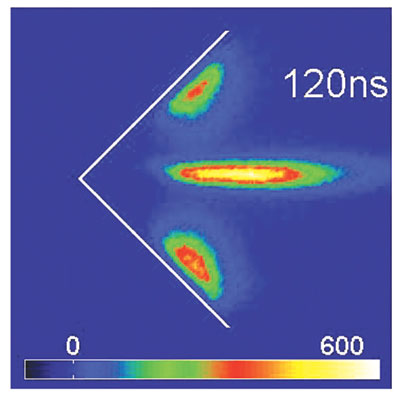Laser produced plasmas (LPP) are formed when a short pulse and high power laser is focused onto a solid surface. LPP are hot (reaching temperatures of up 100 million degrees), they can reach densities close to solids and they are transient with lifetimes of picoseconds to microseconds depending on the pulse duration of the driving laser. Applications range from X-ray sources for lithography, microscopy and radiography to X-ray lasers, thin film device fabrication, analytical spectroscopy and ion beam generation (and even acceleration). Although there is a substantial body of knowledge available in the literature on the creation, evolution and useful application of laser-produced plasmas dating back to the 1960s, little is known about what happens when two such plasmas collide. Funded by SFI and the EU we have undertaken in recent times a detailed study of the fundamental physics governing the interaction of table-top scale colliding laser plasma systems using fast gated (nanosecond) imaging and spectroscopy as the main tools. The accompanying image shows the formation of a stagnation layer (jet like structure) at the collision front between two calcium plasmas taken some 120 nanoseconds after the formation of the two point like source plasmas also seen positioned on either side of the layer.
 The motivation for undertaking these studies is not just mere curiosity. Colliding astrophysical systems are not unusual and laser plasmas can be engineered to possess conditions not dissimilar to plasma jets (e.g., they expand away from the irradiated solid surface at speeds comparable to astrophysical jets, typically 10 kilometres per second). Hence laboratory colliding plasmas can be cast as model astrophysical systems. In addition, there is also some evidence that they may improve the quality of deposited material in device fabrication by pulsed laser deposition. As a result one new line of research in this area we are embarking on (in collaboration with Dr Jean-Paul Mosnier's group) is a new SFI funded project to explore and engineer the stagnation layer into an atomic, molecular and cluster source for potential materials deposition applications. Other proposals and experiments are starting at laboratories in the UK and elsewhere and so the field should grow strongly in the coming years with new and exciting science and applications emerging.
The motivation for undertaking these studies is not just mere curiosity. Colliding astrophysical systems are not unusual and laser plasmas can be engineered to possess conditions not dissimilar to plasma jets (e.g., they expand away from the irradiated solid surface at speeds comparable to astrophysical jets, typically 10 kilometres per second). Hence laboratory colliding plasmas can be cast as model astrophysical systems. In addition, there is also some evidence that they may improve the quality of deposited material in device fabrication by pulsed laser deposition. As a result one new line of research in this area we are embarking on (in collaboration with Dr Jean-Paul Mosnier's group) is a new SFI funded project to explore and engineer the stagnation layer into an atomic, molecular and cluster source for potential materials deposition applications. Other proposals and experiments are starting at laboratories in the UK and elsewhere and so the field should grow strongly in the coming years with new and exciting science and applications emerging.
John T Costello, John Dardis, Hugo de Luna, Kevin Kavanagh, Jofre Pedregosa, Mark Stapleton and Jean Paul Mosnier.
Contact: Prof John T. Costello
Head, School of Physical Sciences,
Dublin City University, Dublin 9
Tel: +353-1-7005304
Fax: +353-1-7005384
E-mail:
[email protected]
Web:
http://www.physics.dcu.ie/~jtc
|

